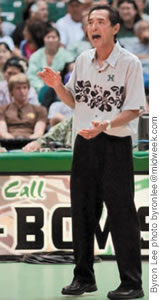How Patsy Helped Shoji Win 1,000

Wednesday - October 28, 2009
| Share
 Del.icio.us
Del.icio.us
|
Dave Shoji stood on the Teraflex court surface draped in lei, cocooned in Silly String and smiling broadly, the beneficiary of hundreds of talented athletes and an often-misunderstood and much-maligned piece of legislation.
Shoji’s ascent to 1,000 victories is more than an indicator of individual success and coaching talent, both of which he has in abundance. It is further proof of the success The Patsy T. Mink Equal Opportunity in Education Act, originally the Title IX of the Education Amendments of 1972.
Most commonly known as Title IX, the legislation is part of an overall civil rights bill that outlaws sexual discrimination in any educational program at schools receiving federal funds. While not always popular and often blamed for the demise of some non-revenue men’s sports, the law created opportunities for the athletes whose skill Shoji turned into champions and for the millions who were finally given the fair chance to compete. The success, as Shoji had pointed out after the game, has been staggering. A 2005 study conducted by the Women’s Sports Foundation found that since 1975, participation by female high school athletes increased 875 percent, while collegiate numbers rose 435 percent. The number of female high school participants increases to 940 percent when stretched to the legislation adoption in 1972.
But while women’s basketball packs arenas in the East and others make for more entertaining contests than those played by their male counterparts - tennis and volleyball specifically - the law that called for equal opportunity has yet to be fully realized.
According to the WSF, compliance is still a long way off. Citing a gender-equity study conducted by the NCAA, the organization’s Web site reports that male collegiate athletes receive $135 million more in athletic scholarships than do female athletes.
Marilyn Moniz-Kaho’ohanohano, the associate athletics director and senior women’s administrator at UH, said the university is in compliance with scholarship and participation requirements, but that in the area of benefits and treatments, work still needs to be done. She also mentioned that the race for equality is burdened by a challenged and unfair financial situation.
“The next hurdle is finances, because the gap between the funding for men’s sports and women’s sports is continuing to widen rather than to close,” says the former Wahine volleyball player. “The female student athletes, I would say in general, are receiving only about 30 percent of the sports budget ... I think we are going backward.”
Moniz-Kaho’ohanohano is not alone pointing out the differences in funding between men and women. A 2002 report by the National Women’s Law Center for the Commission on Oppor-tuni-ties in Athletics said that while women make up 41 percent of Div. 1 athletes, they receive only 32 percent of the recruiting dollars and 36 percent of the operating dollars.
The biggest criticism of Title IX is the presumption that it succeeds at the expense of men’s programs, and that the requirements don’t match the inherit interest in athletics between the sexes.
While it is true that colleges have cut non-revenue men’s sports in recent years, the blame sits not at the feet of gender equity but in the inability of universities to balance their budgets. According to the NCAA, from 2004 to 2006 the median total expenses for Football Bowl Subdivision athletic programs increased 23 percent, while generated revenues increased by just 2 percent since 2005. That number jumps to 22 percent when the numbers from 2004 are added.
As far as the argument that men are more interested in sports and therefore require more scholarships, Moniz-Kaho’ohanohano says that’s an old and tired argument.
“That’s exactly why you have the law to create opportunities so you can create interest ... Of course, 30 years ago women weren’t as interested because there weren’t any opportunities. The law has helped change society’s view of the value of athletics.”
Seeing the near-capacity crowd stand in appreciation of the university’s most successful coach and the state’s second-favorite athletic team on that historic evening, the importance of equal opportunity was obvious.
Change is often difficult, but always necessary.
E-mail this story | Print this page | Comments (0) | Archive | RSS Comments (0) |
Most Recent Comment(s):













